
Students will have 35 minutes to read six passages and answer 36 questions in the Reading Comprehension section. These passages will cover a wide variety of topics, including the humanities (literature, art, biography), social studies (history, economics, sociology), and science (medicine, meteorology, zoology). Each passage is followed by a number of questions that are based on the content of the passage. These questions are not designed to trick you or ask you to think too abstractly about the passage. All answers to these questions can be found within each passage.
Types of Reading Comprehension Questions
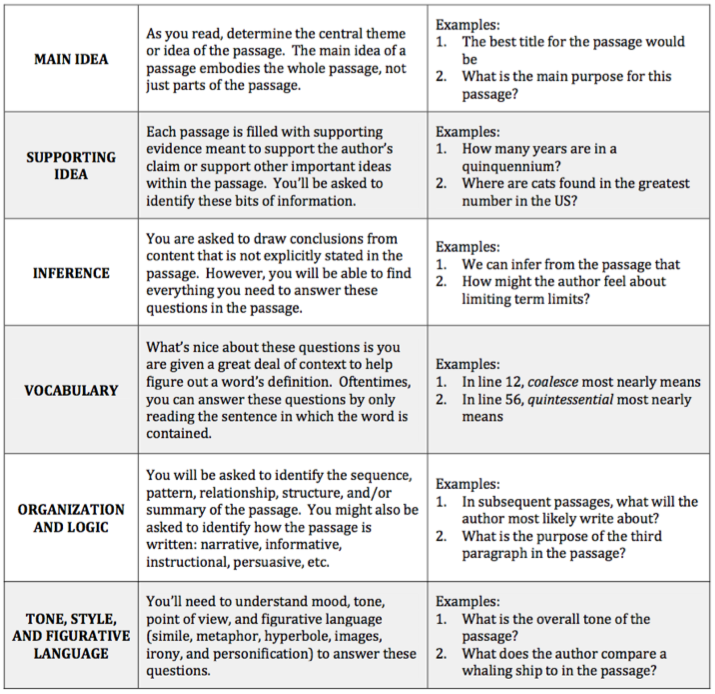
Understanding Tone, Style, and Figurative Language
In writing, authors have many tools at their disposal to help them inform or persuade the reader of something. With tone, authors project their attitude towards the passage’s subject through careful word choice (such as filling a passage with negative words to reflect an author’s hatred of something).
With style, authors can influence how the reader perceives or understands what is going in in the passage by playing with sentence structure or using informal/formal language.
With figurative language, authors can further influence a reader’s perception of something through odd comparisons or imagery that evokes an emotion unfelt through literal description (plainly describing something versus using similes and metaphors).
The following terms should be familiar to you, but spend a moment refreshing your memory of them:
- Mood—the atmosphere that pervades a passage with the intention of evoking a certain emotion or feeling from the reader
- Tone—the author’s attitude towards the subject being addressed in the passage which is communicated through the words chosen by the author
- Point of view—the intellectual perspective held by the author of the passage
- Figurative Language—“ornaments of language;” language that does not mean exactly what it says
- Simile—a comparison of two unalike things
- Metaphor—a statement that says one thing is something else, when it is literally not
- Hyperbole—an extravagant exaggeration used for emphasis
- Images—words or phrases that appeal directly to the reader’s senses
- Irony—the use of words that convey a meaning that is opposite to its literal meaning; an outcome of events that is contrary to what was or might have been expected
- Personification—the act of giving objects or nonhuman organisms human characteristics
Systematic Approach to Reading Comprehension Questions
The Reading Comprehension section is decidedly different from the other sections, but it is still very important to have a systematic approach to answering its questions. The passages can seem very intimidating (or boring), which can hinder your ability to properly answer every question. By using a systematic approach (which includes Active Reading), you can cut down how much you actually read of the passage. Also, you can sometimes answer questions without actually reading the passage.
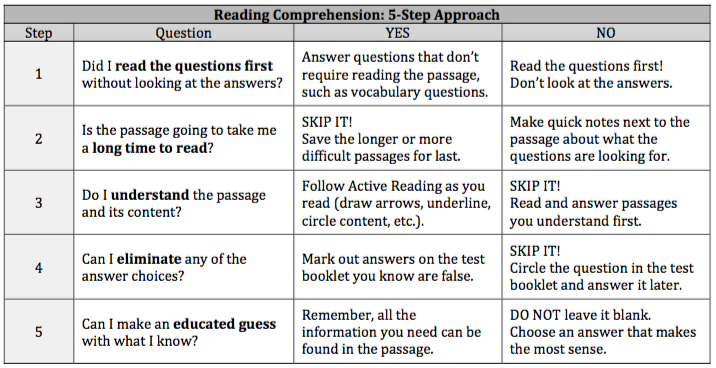
Active Reading
For many students, the ISEE’s Reading Comprehension passages, to put it bluntly, will be really boring (particularly for students who do not enjoy reading). If something is boring, you usually do not want to put much effort into reading it and information will not stay with you. You will be forced to read and reread the passage over and over again. You will spend more time reading than answering questions, and you will likely score poorly overall. However, there is hope! You can utilize active reading to make whether or not the passage is boring or interesting a moot point.
Active reading refers to the process of note taking and engagement while reading the passage (and even before!). You will decrease the amount of time you spend reading the passage, and you will answer the questions more efficiently and accurately.
Active Reading Step 1
- Read every question relating to the passage before you read the passage.
- Do NOT read the answer choices.
- Make notes near the passage detailing what you are supposed to look for in the passage.
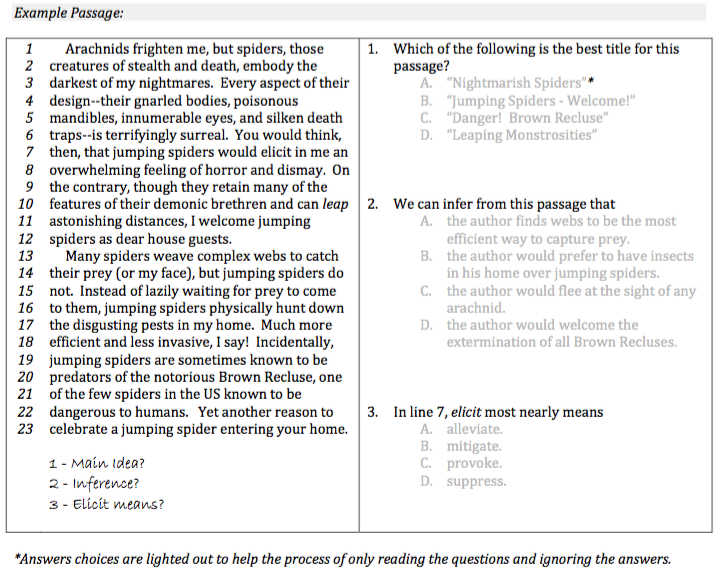
Active Reading Step 2
- Attempt to answer some of the questions before actually reading the passage
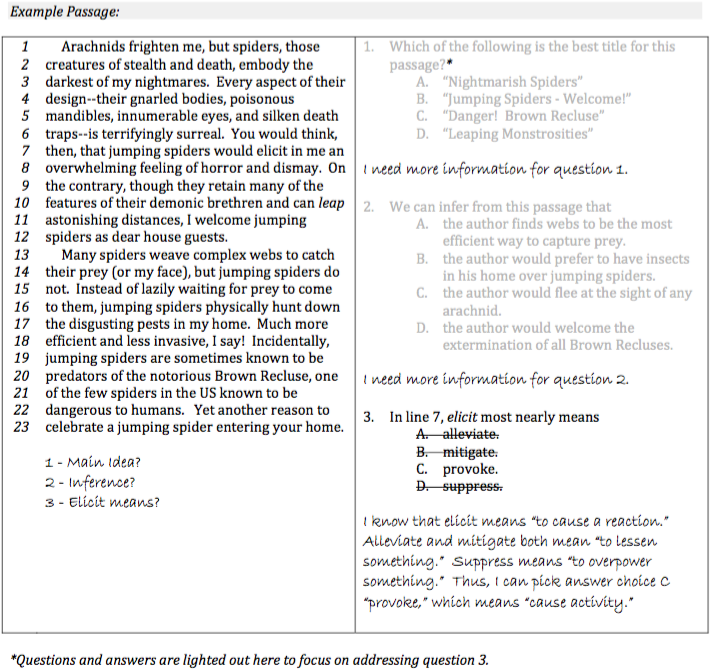
Active Reading Step 3
- You are allowed to write all over your test booklet on the ISEE.
- Make use of this by circling and underlining portions of the passage you feel answer the accompanying questions.
- You can also draw arrows between the questions and the portions of the passage you think answer them and write notes as you read.
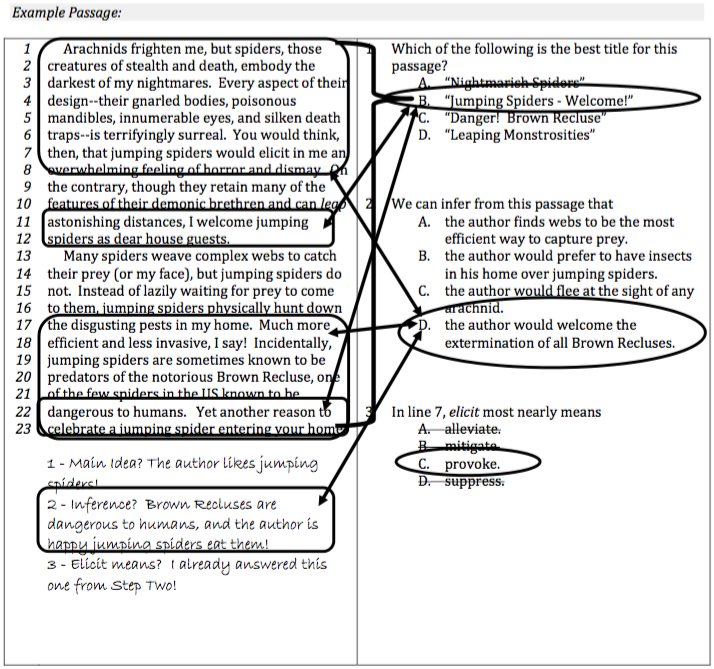
Active reading Step 4
- Double check your responses using your notes and your highlights from the passage.
- Question 1:
- “Nightmarish Spiders” works for the first part of the passage, but the author is using this imagery as a contrast against how much he likes the jumping spider.
- “Jumping Spiders – Welcome!” captures the overall scope of the passage.
- “Danger! Brown Recluse” only works for the last few sentences of the passage.
- With “Leaping Monstrosities,” the author hates regular spiders, not jumping spiders, so this title does not work at all.
- Question 2:
- The author thinks webs are inefficient compare to how the jumping spider hunts, so this does not work.
- The author praises how efficiently the jumping spider hunts insects and other prey, which he calls “disgusting pests.” This answer choice doesn’t work.
- While this answer choice seems correct, you must remember that the author likes jumping spiders, also an arachnid, and would not flee at the sight of one.
- The author states Brown Recluses are dangerous to humans and celebrates the fact that jumping spiders are a predator of the Brown Recluse. If the author celebrates the killing of a Brown Recluse, he would easily celebrate the Brown Recluses’ extermination.
- Question 3: If you don’t know the definition of the word, use the context of the passage and the strategies you know for defining words to decipher the word.
- Alleviate means “to make pain or hardship more bearable or less severe,” which is pretty much the same thing as mitigate.
- Mitigate means “to make something less harsh, severe, or violent,” which is pretty much the same thing as alleviate.
- Provoke means “to be the cause or occasion of an emotion or response,” meaning spiders incite the author to feel terror.
- Suppress means “to put an end to something or overpower something,” meaning seeing a spider would stop his fear, which is the opposite of what the author is stating.
This process may seem slow at first, but you will find it speeds up considerably the more you use Active Reading and get used to its steps. The name of the game is efficiency, and Active Reading will help you read more quickly and (more importantly) retain more information from a single read through. Plus, it can limit how much of the passage you actually have to read, saving you even more time for the more difficult passages.
Summary of Active Reading Steps

Let’s Practice
Piqosity allows you to take free practice quizzes and receive analysis of your performance including details on question difficulty level and a comparison to how your peers did on the same question. You can use questions already on Piqosity or upload your own.
The sample quiz…
—
This How-To Guide is excerpted from “Upper Level ISEE Prep Guide with 6 Full-Length Practice Tests, 3rd Edition” by Stephen Hayes and the Staff of General Academic. You can buy it on Amazon for about $50.



[…] Reading Comprehension Questions on the Upper Level ISEE […]